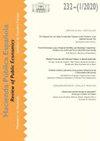How Did the ‘Dualization’ of the Spanish Income Tax Affect Horizontal Equity? Assessing its Impact Using Copula Functions
IF 0.5
4区 经济学
Q3 ECONOMICS
Hacienda Publica Espanola-Review of Public Economics
Pub Date : 2019-12-01
DOI:10.7866/hpe-rpe.19.4.3
引用次数: 1
Abstract
The aim of this paper is to assess horizontal inequity (HI) caused by the introduction of a (semi-) dual structure for the Spanish personal income tax (PIT), adopting a copula function-based measurement framework. Following Bo et al. (2012), we estimate the Clayton, Frank and Gumbel copulas, belonging to the Archimedean class, to quantify the impact of the 2007 Spanish PIT reform on HI, comparing it with the previous tax design applied in 2006. In order to identify possible anticipation and adaptation effects, the analysis covers the 2004-2010 period. This research employs microdata from the Spanish PIT Return Panel. Results reveal two effects of the reform on the HI working in opposite directions: while the partition of the taxable income into two bases (one is taxed at ˜at rate) increases the HI, the transformation of personal and family allowances into tax credits reduces it. The predominance of one effect over the other depends on the equivalence scale applied.西班牙所得税“二元化”如何影响横向公平?使用Copula函数评估其影响
本文的目的是采用基于copula函数的测量框架,评估西班牙个人所得税(PIT)引入(半)二元结构所造成的横向不公平(HI)。根据Bo等人(2012),我们估计了属于阿基米德类的Clayton、Frank和Gumbel copula,以量化2007年西班牙PIT改革对HI的影响,并将其与2006年应用的先前税收设计进行了比较。为了确定可能的预期和适应影响,分析涵盖了2004-2010年期间。这项研究采用了西班牙PIT返回小组的微观数据。结果表明,改革对HI产生了两种相反的影响:虽然将应税收入划分为两个基数(一个按税率征税)会增加HI,但将个人和家庭津贴转变为税收抵免会降低HI。一种影响比另一种影响更大取决于所采用的等效规模。
本文章由计算机程序翻译,如有差异,请以英文原文为准。
求助全文
约1分钟内获得全文
求助全文
来源期刊

Hacienda Publica Espanola-Review of Public Economics
Economics, Econometrics and Finance-Finance
CiteScore
0.90
自引率
14.30%
发文量
14
期刊介绍:
Hacienda Pública Española/Review of Public Economics welcomes submissions on all areas of public economics. We seek to publish original and innovative research, applied and theoretical, related to the economic analysis of Government intervention. For example, but not exclusively: Taxation, Redistribution, Health, Education, Pensions, Governance, Fiscal Policy and Fiscal Federalism.
In addition to regular submissions, the journal welcomes submissions of:
-Survey Reviews, containing surveys of the literature regarding issues of interest in the Public Economics field;
-Policy oriented reviews, showing the current contributions of Public Economics in relation to relevant contemporary issues affecting public decision-makers in the real world (Policy Watch);
-Comments of previously published articles. Contributions to this section should be limited to a maximum of 2 000 words (12 pages). If deemed adequate, the authors of the commented article will be given the opportunity to react in a Reply. Both Comment and Reply will be published together.
Articles for the Survey Reviews and Policy Watch section are subject to the same double blind reviwing procedure. The adequacy of Comments submitted for publication will be evaluated by the Executive Editors.
 求助内容:
求助内容: 应助结果提醒方式:
应助结果提醒方式:


